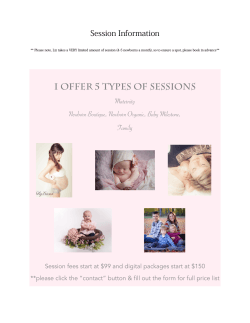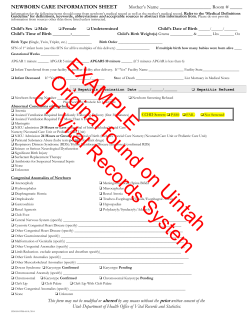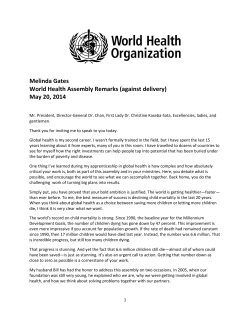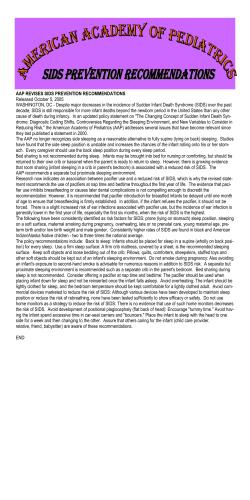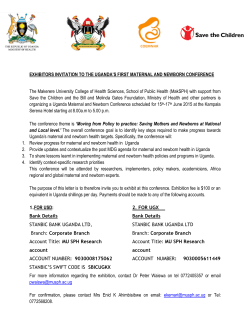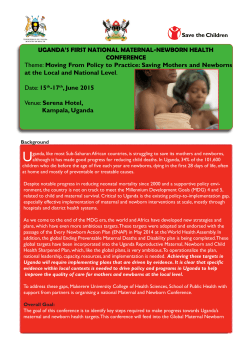
Preventing In-Hospital Newborn Falls
4/23/2015 Nursing Center Print CE Article Print this page Close window Preventing InHospital Newborn Falls: A Literature Review Tara Matteson MS, RN, CBS Audery HendersonWilliams MS, RN Jessica Nelson DNP, RN MCN, The American Journal of Maternal/Child Nursing December 2013 Volume 38 Number 6 Pages 359 366 Keywords: Accidental , Falls , MaternalChild , Maternity Hospitals , Newborns , Nursing. Abstract Abstract: Inhospital newborn falls are arguably one of the most underresearched and underreported issues for organizations that care for newborn patients. From the few published statistics of inhospital fall rates, we know that perhaps 600 to 1,600 newborn falls occur annually. Many of these falls can result in injury or even death of the newborn, legal issues for the institution, and severe emotional stress to the caregiver(s) and parents. Therefore, we searched the literature to ascertain causation and associated risks associated with inhospital newborn falls. This is an important issue for nurses to understand because not only can the newborn be harmed due to a fall, but the actual newborn fall can also elicit strong feelings of guilt and culpability in the caregiver(s). This article reviews the literature to examine what is known about the factors associated with in hospital newborn falls, to explore prevention measures, and to present best practices for how to adopt safesleep policy to prevent newborn falls. Prevention of inhospital falls among patients is a vital issue for all healthcare organizations. In order to best protect patients, both the Institute of Medicine and the Joint Commission identify patient safety problems, sanction improvement needs, and promote safety system development (Institute of Medicine, 2012; The Joint Commission, 2012). By ensuring the safety of the newborn during hospitalization, medical professionals can promote an overall culture of safety for patients and caregivers. According to Phalen and Smolenski (2010), inhospital newborn falls are defined as a newborn falling onto the hospital floor accidentally. This can be caused by judgment errors from the hospital staff or caregiver(s), or could be due to environmental factors (Paul, Goodman, Remorino, & Bolger, 2011; Phalen & Smolenski, 2010). The risk of newborn falls begins at the time of birth and continues throughout the duration of the hospital stay. Figure. No caption available. The issue of newborn falls within the inpatient setting is multifaceted due to the physical, emotional, and psychological complexities for all who are involved. Newborns are a vulnerable population and rely solely on their caregivers to protect them from injuries. Newborn falls concern all stakeholders because of resultant physical trauma to the newborn, legal issues, increased financial costs, and subsequent emotional distress to the family (Monson, Henry, Lambert, Schmutz, & Christensen, 2008). Background and Significance Starting in the late 1930s and increasing in the 1940s, the emergence of roomingin became a trend across the United States. Roomingin is a term first discussed by Gesell and Ilg (as cited in Jackson, Olmsted, Foord, Thomas, & Hyder, 1948). "Rooming in is the term . . . in use to designate the hospital arrangement whereby a mother may have her newborn baby in a crib by her bedside whenever she wishes" (Jackson et al., 1948, p. 28). Studies have shown that roomingin is beneficial to promote breastfeeding initiation, bonding, and closeness between mothers and newborns (Jaafar, Lee, & Ho, 2012). Although there are many benefits to roomingin, one of the possible problems can be overlooking important basic safety considerations; this can pose serious risks to the safety of newborns. The leading cause of nonfatal injuries in children ages 0 to 19 are falls (Centers for Disease Control and Prevention [CDC], 2012). Initial data have shown that inhospital newborns falls occur at a rate of 1.6 to 4.14/10,000 live births (approximately http://www.nursingcenter.com/lnc/ce_articleprint?an=0000572120131100000007 1/6 4/23/2015 Nursing Center Print CE Article 6001,600 newborn falls annually) (Helsley, McDonald, & Stewart, 2010). The majority of documented falls occurred when the mother fell asleep while holding the newborn in a bed or reclining chair; additional falls have occurred during birth or transportation (Abike et al., 2010; Helsley et al., 2010). The development and implementation of a safesleep protocol or policy is one extremely important method to prevent in hospital newborn falls. Thompson (2005) noted that, although parents may desire to sleep with their newborn, the need for continuous monitoring and assessment, paired with the risk of injury from falling or entrapment, is a priority consideration in the delivery of optimal patient care within the hospital setting. Therefore, policy guidelines that discuss and promote separate, but close, sleep spaces between mothers and newborns should be followed to reduce the risk of injury to newborns during sleep. Thompson (2005) also suggests that parental education on the risks of bedsharing (entrapment, suffocation, and Sudden Infant Death Syndrome [SIDS]) should be conducted by hospital staff. The purpose of this article is to examine best practices related to preventing inhospital newborn falls. Search Criteria We conducted a literature review to identify the prevalence of inhospital newborn falls. Initial searches yielded three appropriate articles. Due to this limited amount of articles, the search criteria were expanded to include other areas of concern that may increase the risk of falls for newborns. The search criteria included keywords such as newborn falls, infant falls, safe sleep policies, preventing newborn falls, safesleep environments, cosleeping, bedsharing, and SIDS. These terms were entered into EBSCOhost databases: Academic Search Premier, CINAHL, MEDLINE, ProQuest, and PsycINFO. The quantitative and qualitative evidence published between 2002 and 2012 that addressed a multitude of issues surrounding newborn falls was examined. The final 10 studies were analyzed and selected based on strength of the research and clinical support, and applicability. These studies included quantitative studies, case control studies, crosssectional surveybased studies, retrospective chart reviews, live query of event databases, qualitative studies, and systematic review (Table 1). Table 1: Summary of EvidenceBased Findings Literature Review The studying and reporting of inhospital newborn falls is a relatively new topic of concern, thus limited publications were available. Only two studies (Helsley et al., 2010; Monson et al., 2008) provided statistics concerning newborn falls within the hospital setting. Regarding falls in the adult population, Morse (2009) noted that 6% of adult patient falls result in serious injuries that can culminate into compromised health situations and, in more severe cases, death. The author classified falls into three groups: accidental, anticipated, and unanticipated physiological falls (Morse, 2009). The majority of inhospital newborn falls can be classified under anticipated physiological falls, which can be prevented by first identifying those who are at risk. Patients who are classified as medium or high fall risk should be assessed in order to correct or lower the possible cause of falling; a nursing care plan should be developed and implemented. Some new mothers are at especially high fall risk; mothers who are unsteady or impaired are themselves at risk as are their newborns due to unstable ambulation or increased drowsiness from medication. Some mothers may also try to stay in their beds when placing their newborns in a bassinet; this increases risk of newborn falls. Morse (2009) concluded that preventing inhospital newborn falls requires an approach that is coordinated, planned, and involves all staff members. It is important to note that different organizations have varying policies in place that may or may not allow parents to walk with newborns in their arms. It is imperative for staff members to know their organization's policies that relate to this topic to appropriately address the issue. Over a 2year period, Helsley et al. (2010) completed a query of a database of a sevenhospital system. During that time, newborn falls were reported at a rate of 9/22,866 births, resulting in an overall fall rate of 3.94/10,000 births. This fall rate equates to approximately 600 to 1,600 falls each year in the United States (Helsley et al., 2010). The majority of these falls occurred when the mother fell asleep with the newborn in her arms. Close physical interaction between the mother and infant primarily occurs during infant feeding and skintoskin contact; hospitals are therefore faced with the challenge of balancing the important aspects of bonding and safety for both the mother and newborn. Utilizing established BabyFriendly Hospital Initiative guidelines for assessing the level of fall risk for newborns, Helsley et al (2010) then recreated interventions to reduce the rate of inhospital newborn falls. Interventions recommended included the creation and development of the patient safety contract, improving equipment safety, and educating mothers on information related to newborn falls. Galuska (2011) discussed the creation and implementation of a universal newborn fall prevention program. Core elements of this program included parent teaching, a pledge form signed by parent and nursing staff to support patient safety, infant safety signs, utilization of hourly rounds, and promotion of maternal rest. An important aspect of this program incorporates assessing mother's sleepiness during hourly rounds. If a mother is found to be sleepy or sleeping during rounding, staff members intervene and place the newborn in the crib to ensure safety (Galuska, 2011). Prior to this program, five newborn falls occurred in 1 year. Since the development of the newborn fall prevention program, that institution has not had a documented newborn fall in 11 months (Galuska, 2011). This evidence supports the notion that the implementation of a newborn fall prevention program is a meaningful intervention. Ruddick, Platt, and Lazaro (2010) concluded that newborns are susceptible to skull fractures, even when falling from lowerlevel surfaces. They conducted a chart review that queried an event database to review newborn falls occurring on a postnatal ward over a 5year period. Eleven newborns were included in the review, but not all newborns were radiographed postfall. The majority of newborns in the study fell from their mothers' arms or knees when in a bed or chair; one newborn fell from a mother's arms while being placed in a bassinette, and one newborn fell from a delivery bed (Ruddick et al., 2010). Although the http://www.nursingcenter.com/lnc/ce_articleprint?an=0000572120131100000007 2/6 4/23/2015 Nursing Center Print CE Article majority of newborns did not sustain significant known head trauma (no physical trauma signs such as swelling and bruising), three newborns had single linear parietal skull fractures, and one newborn exhibited signs of traumatic encephalopathy with left parietal and frontoparietal fractures (Ruddick et al., 2010). This demonstrates that falls can cause significant damage even from lowerlevel surfaces, and attention needs to be given in order to prevent physical head trauma in the newborn. Paul et al. (2011) posit that newborn inhospital falls remain underrecognized and underreported by healthcare professionals and caregivers. Many times after a newborn falls, caregivers may experience feelings of guilt or fear, which may cause falsification, delay, or underreporting of such incidences. They also note that the most common cause of newborn falls was the mother falling asleep while holding the newborn. Strategies suggested to reduce these incidences are parental education about the potential for newborn falls out of the maternal bed or from a chair, discouraging sleeping while holding the newborn, and parents informing staff members when taking their baby to bed. In order to make parents aware and realize the importance of reporting any incidences of falling, a nonjudgmental approach is suggested (Paul et al., 2011). Not only are awareness and education important factors in preventing inhospital newborn falls, but we also need to know how to implement recommendations and suggestions to change practice. Hitchcock (2012) reviewed the American Academy of Pediatrics' (AAP) recommendations for safe sleep. While promoting safesleeping conditions is of utmost importance for decreasing injury and increasing the survival of newborns, staff members who care for newborns are inconsistent in the message they give to new parents (Hitchcock, 2012). All staff members must be aware of the AAP's best practice guidelines and follow the given recommendations as this will provide a consistent message among all providers who take care of newborns. The incorporation of a safesleep policy that highlights safesleep guidelines and promotes a clear message of how to implement such practices ensures all staff caring for newborns will follow and support best practice guidelines (Hitchcock, 2012). In 2011, the AAP reaffirmed best practice guidelines regarding SIDS prevention measures for infants. In order to help reduce infant deaths during sleep, the AAP expanded upon their previous guidelines to include safesleeping practices that focus on SIDS prevention measures along with safesleeping environments (American Academy of Pediatrics [AAP], 2011a). Although the majority of the guidelines are related to the home environment, the AAP has started focusing on hospital measures that can accompany the guidelines; incorporating safesleep practices immediately after birth will aid caregivers in adopting safesleep practices. Although all of the AAP recommendations are important to incorporate into practice, five recommendations support the prevention of inhospital newborn falls: 1. supine sleep position, 2. firm sleep surface, 3. roomsharing without bedsharing, 4. avoiding alcohol and illicit drug prenatally and postpartum, and 5. using SIDS riskreduction recommendations by all healthcare providers starting at birth (AAP, 2011a). Back to Sleep Discussing safesleep practices is essential in order to prevent infant falls. The risk of falls greatly decreases in infants that are placed on their back and in their own sleep space when being placed down for rest (AAP, 2011b). The "Safe to Sleep" campaign, formerly known as the "Back to Sleep" campaign, aims to educate healthcare professionals, parents, and caregivers regarding the importance of the supine sleeping position. Since 1994, this campaign has significantly reduced the number of infant deaths related to SIDS by 50% and increased the number of infants sleeping on their backs (National Institute of Child Health & Human Development [NICHD], 2012). However, over the past 10 years, the number of infant deaths related to SIDS has plateaued (NICHD, 2012) that signifies a need for further education and intervention on this issue. Infants placed on their stomach or side before sleeping have an increased risk for SIDS, hypercapnia, and hypoxia resulting from rebreathing exhaled gases, overheating, and diminished sleepwake cycles that allow the infant to respond to stressors during sleep (American Academy of Pediatrics [AAP], 2011b). Infants placed in the side sleep position are "...inherently unstable, and the probability of an infant rolling to the prone position from the side sleep position is significantly greater than rolling prone from the back" (AAP, 2011b, p. e1347). Infants are more likely to be in the prone or side position when sleeping with a parent/caregiver (Baddock, Galland, Bolton, Williams, & Taylor, 2006). The infant is vulnerable to injury if placed on an unsafe sleeping surface due to rolling, falling, suffocation, or entrapment (AAP, 2011b). Sleep Surface The AAP (2011b) recommends that infants be placed on a firm sleep surface with a fitted cover, and no loose bedding or soft objects in the sleeping area. According to the AAP (2011b), "[m]attresses should be firm and should maintain their shape even when the fitted sheet designated for that model is used, such that there are no gaps between the mattress and the side of the . . . portable crib..." (p. e1349). These safesleep practices are recommended in order to reduce the risk of SIDS and other injuries resulting from suffocation and entrapment, which correlates with inhospital fall prevention measures; positive role modeling should begin immediately after the birth. RoomSharing as Compared to BedSharing Defining the terms roomsharing, cosleeping, and bedsharing are fundamental in order to properly discuss optimal infant sleeping environments. Roomsharing is when an infant sleeps ". . . in the parents' room but on a separate sleep surface (crib or similar surface close to the parents' bed" (AAP, 2011b, p. e1350). Cosleeping is when the infant and parent ". . . sleep in close proximity (on the same surface or different surfaces) so as to be able to see, hear, and/or touch each other" (AAP, 2011b, p. e1350). Bedsharing is ". . . a specific type of cosleeping when the infant is sleeping on the same surface with another person" (AAP, 2011b, p. e1350). As cosleeping is a term easily confused with others, the AAP (2011b) recommends using roomsharing and bedsharing to describe sleep practices; roomsharing is the recommended sleep practice by the AAP (2011b). To ensure optimum safety, infants should be placed in their own sleep area in a crib, bassinette, or similar sleep space. The term bedsharing does not specifically relate to only sleeping or sharing a bed. Infants should also not sleep on other soft surfaces such as couches or armchairs, with or without parents. The topic of bedsharing is highly controversial as many people associate bedsharing with attachment, bonding, and improved breastfeeding rates (AAP, 2011b). In Helsley et al's. (2010) study, of the nine newborn fall cases documented, all infants were in bed with a caregiver (mother or father) during the time when falls occurred. http://www.nursingcenter.com/lnc/ce_articleprint?an=0000572120131100000007 3/6 4/23/2015 Nursing Center Print CE Article Prenatal and Postnatal Exposure to Alcohol and Illicit Drugs We all know that alcohol, tobacco, and illicit drug use pose significant health risks to women of childbearing age and their infants. What we need to do is a better job of assessing whether a risk exists for the infant when he or she goes home with a parent or caregiver who might be impaired by substances. A parent under the influence of drugs or alcohol may become easily tired and fall asleep on any surface with an infant in their arms and subsequently drop the infant. An infant is at an even higher risk for injury and possible death when the mother is impaired by substances and bedshares. Nurses should be alert for this risk in the parents, and address it with them. Floyd et al. (2008) concluded that if an illicit substance is used during the preconception period it is likely to be used in the prenatal period. Blair et al. (2009), found that "[m]any of the deaths while cosleeping occurred in potentially hazardous environments, including a sofa or shared surface with an adult who had recently consumed alcohol or narcotics" (p. 920). While in the hospital, it is important for staff members to monitor all mothers, but especially those who have a history of substance abuse. Improving Educational Interventions for all Healthcare Providers Improving the education of parents, caregivers, and healthcare professionals regarding safesleep practices is vital to the safety of newborns. The most critical opportunity for healthcare providers to influence parents' behavior is during 24 to 48 hours after birth (First Candle, 2012). "Despite the fact that more than two thirds of nursery staff correctly identified supine placement as the preferred position for SIDS risk reduction, exclusive use and recommendation of the supine position was surprisingly low among nursery staff. . ." (Stastny, Ichinose, Thayer, Olson, & Keens, 2004, p. 125). Hitchcock (2012) discusses the fact that " [i]nfant sleep policies need to be written or revised to reflect the latest guidelines and staff expectations" (p. 394). In order to present a unified message to all parents, nursing staff and healthcare providers must be aware of best practice guidelines and incorporate them into their practice (Hitchcock, 2012). If healthcare providers are permitting parents to bedshare with their newborns in the hospital, then this message and practice can easily be adopted in the home setting. The two studies that looked at inhospital newborn falls by Monson et al. (2008) and Helsley et al. (2010) found the majority of newborns who had fallen in hospital fell out of the arms of their parent/caregiver while in bed. Limitations Due to the minimal amount of information that has been written on this topic, further research is recommended. Other limitations include lack of financial information needed for implementation, unknown number of staff needed to construct and implement a policy, and how a safesleep policy will impact the different cultural and ethnic populations. Of the literature reviewed, only one study utilized a developed newborn fall risk assessment (Abike et al., 2010). The creation of a postfall algorithm would be beneficial in order to standardize care for newborns. Due to the underreported nature and underdocumented accounts of inhospital newborn falls, the true incidence is not widely known. Therefore, an accurate assessment and evaluation cannot be constructed in order to fix the issue. Clinical Nursing Implications The implementation of best practice guidelines requires support from administration, leadership, and staff who care for mothers and newborns. In order to implement a safesleep policy within an organization, all staff involved must be committed to promoting and protecting a vulnerable population that cannot protect itself. Thompson (2005) discusses the strategies that must be included in order to incorporate these changes: 1. educating staff by utilizing staff meetings, inservices, and bulletin boards; 2. educating medical providers about the policy through written and verbal discussion; 3. informing all parties about policy intention and included content to the hospital's patient advocacy department to assist with concerns and complaints; and 4. verbal and written communication with the hospital's translation services department to address cultural practices and assist with patient materials that require translation. By providing parents with written materials prenatally, and scheduling meetings with childbirth educators in order to help disseminate information, healthcare professionals can help to provide a consistent, clear, and standardized message that will help reinforce best practice guidelines that will improve infant safety and injury prevention. Nurses should ensure community based informational resources are available and accessible for women postdischarge especially for those of low socioeconomic status (Sword & Watt, 2005). The costs associated with such practices include monies for written materials for staff, medical providers, and translation services, and staff salaries that support policy development, educational inservices, and possible remediation (Thompson, 2005). Although the frequency rate of newborn falls is relatively small, researchers have shown that newborn falls do occur. The incorporation of best practice guidelines in safesleep policies in order to enhance fall prevention is crucial to help improve the safety of newborns. Conclusion In order to help prevent newborn falls, facilities should implement and utilize a standardized risk assessment for falls upon admission in addition to a tracking system that will monitor the occurrence of newborn falls. The statistics that would become available will help uncover the true prevalence of this issue. Further evidencebased practice is crucial in order to improve practice and make enhancements in the prevention of inhospital newborn falls. The creation of safesleep policies that utilize the AAP guidelines for SIDS prevention and safesleep environments will provide organizations with the foundational measures for ensuring proper safesleep environments to prevent newborn falls and promote newborn safety. Incorporating these measures in safesleep policies will help with standardizing practitioner care and consistent messages to all families with newborns. The promotion of newborn safety is pivotal to all institutions who care for this population. Newborn falls are preventable injuries. The confounding variables involved in newborn falls are multifaceted. In order for newborns to remain safe, healthcare professionals must find a balance that supports nurturing, attachment, and bonding among caregivers and newborns along with the prevention of newborn falls. By utilizing existing evidence and expanding upon the current academic literature, researchers can begin to address this preventable injury. Suggested Clinical Nursing Implications http://www.nursingcenter.com/lnc/ce_articleprint?an=0000572120131100000007 4/6 4/23/2015 Nursing Center Print CE Article Nurses who care for mothers and newborns should consider: * Reading the literature on this topic * Knowing that bedsharing can be a risk, as well as the mother falling asleep while the baby is feeding, or the mother trying to put the infant back in the hospital bassinet while she is still in bed. * Working with all stakeholders to utilize a current risk assessment tool, or to develop a risk assessment tool for newborn falls * Documenting newborn falls in your institution * Consider an hourly rounding policy to assess maternal sleepiness, one of the major risk factors for newborn falls. * Recognize the risks of newborn falls during motherbaby care situations * Implementing a safesleep policy within your organization (no bedsharing for sleeping), and including all staff in the implementation process including healthcare providers, nurses, support personnel, and hospital administrators. * Educating all staff about the new policy for safe sleeping utilizing employee meetings, inservices, and bulletin boards. * Assessing patient's learning style, preferences, and knowledge deficits about infant falls upon admission. * Teaching mothers, fathers and all other home caregivers about the risk of newborn falls in the hospital and at home. Having the patient and other caregivers repeat back the teaching to you so you can clear up any misunderstandings. * Developing patient teaching materials the parents can take home to remind them of what was taught. * Using the institution's translation services to help address verbal and written communication in languages used in your community. ONLINE American Academy of Pediatrics Figure. No caption available. http://www.aap.org First Candle http://www.firstcandle.org National Institute of Child Health & Human Development http://www.nichd.nih.gov References Abike F., Tiras S., Dunder I., Bahtiyar A., Akturk Uzun O., Demircan O. (2010). A new scale for evaluating the risks for in hospital falls of newborn infants: A failure modes and effects analysis study. International Journal of Pediatrics, 2010, 19. http://dx.doi.org/10.1155/2010/547528[Context Link] American Academy of Pediatrics. (2011a). Policy statementSIDS and other sleeprelated infant deaths: Expansion of recommendations for a safe infant sleeping environment. Pediatrics, 128(5), 10301039. http://dx.doi.org/10.1542/peds.2011 2284[Context Link] American Academy of Pediatrics. (2011b). Technical reportSIDS and other sleeprelated infant deaths: Expansion of recommendations for a safe infant sleeping environment. Pediatrics, 128(5), e1341e1367. http://dx.doi.org/10.1542/peds.20112285[Context Link] Baddock S. A., Galland B. C., Bolton D. P., Williams S. M., Taylor B. J. (2006). Differences in infant and parent behaviors during routine bed sharing compared with cot sleeping in the home setting. Pediatrics, 117(5), 15991607. http://dx.doi.org/doi:10.1542/peds.20051636[Context Link] Blair P. S., Sidebotham P., EvasonCoombe C., Edmonds M., HeckstallSmith E. M., Fleming P. (2009). Hazardous cosleeping environments and risk factors amenable to change: Casecontrol study of SIDS in south west England. British Medical Journal, 339(7725). 911920. http://dx.doi.org/10.1136/bmj.b3666[Context Link] Centers for Disease Control and Prevention. (2012). Protect the ones you love: Child injuries are preventable. Retrieved from http://www.cdc.gov/SafeChild/Falls/[Context Link] First Candle. (2012). http://www.firstcandle.org[Context Link] http://www.nursingcenter.com/lnc/ce_articleprint?an=0000572120131100000007 5/6 4/23/2015 Nursing Center Print CE Article Floyd R. L., Jack B. W., Cefalo R., Atrash H., Mahoney J., Herron A., ..., Sokol R. J. (2008). The clinical content of preconception care: Alcohol, tobacco, and illicit drug exposures. American Journal of Obstetrics and Gynecology, 199(6 Suppl 2), S333S339. http://dx.doi.org/10.1016/j.ajog.2008.09.018[Context Link] Galuska L. (2011). Prevention of inhospital newborn falls. Nursing for Women's Health, 15(1), 5961. http://dx.doi.org/10.1111/j.1751486X.2011.01611.x[Context Link] Helsley L., McDonald J. V., Stewart V. T. (2010). Addressing inhospital "falls" of newborn infants. The Joint Commission Journal on Quality and Patient Safety, 36(7), 327333. Retrieved from http://oregon.providence.org[Context Link] Hitchcock S. (2012). Endorsing safe infant sleep: A call to action. Nursing for Women's Health, 16(5), 386396. http://dx.doi.org/10.1111/j.1751486X.2012.01762.x[Context Link] Institute of Medicine of the National Academies. (2012). http://www.iom.edu[Context Link] Jaafar S. H., Lee K. S., Ho J. J. (2012). Separate care for new mother and infant versus roomingin for increasing the duration of breastfeeding. Cochrane Database of Systematic Reviews, 9, CD006641. http://dx.doi.org/10.1002/14651858.CD006641.pub2[Context Link] Jackson E. B., Olmsted R. W., Foord A., Thomas H., Hyder K. (1948). A hospital roomingin unit for four newborn infants and their mothers; descriptive account of background, development, and procedures with a few preliminary observations. Pediatrics, 1(1), 2843. Retrieved from http://pediatrics.aappublications.org[Context Link] Monson S. A., Henry E., Lambert D. K., Schmutz N., Christensen R. D. (2008). Inhospital falls of newborn infants: Data from a multihospital health care system. Pediatrics, 122(2), e277e280. http://dx.doi.org/10.1542/peds.20073811[Context Link] Morse J. M. (2009). Preventing patient falls: Establishing a fall intervention program (2nd ed.). New York, NY: Springer. [Context Link] National Institute of Child Health & Human Development. (2012). Safe to sleep public education campaign. Retrieved from http://www.nichd.nih.gov/sids/[Context Link] Paul S. P., Goodman A., Remorino R., Bolger S. (2011). Newborn falls inhospital: Time to address the issue. The Practising Midwife, 14(4), 2932. Retrieved from http://www.practisingmidwife.co.uk[Context Link] Phalen A. G., Smolenski J. (2010). Newborn falls: Seeking solutions for a never event. Journal of Obstetric, Gynecologic, & Neonatal Nursing, 39(s1), S46. http://dx.doi.org/10.1111/j.15526909.2010.01120_5.x[Context Link] Ruddick C., Platt M. W., Lazaro C. (2010). Head trauma outcomes of verifiable falls in newborn babies. Archives of Disease in Childhood: Fetal Neonatal Edition, 95(2), F144F145. http://dx.doi.org/10.1136/adc.2008.143131[Context Link] Stastny P. F., Ichinose T. Y., Thayer S. D., Olson R. J., Keens T. G. (2004). Infant sleep positioning by nursery staff and mothers in newborn hospital nurseries. Nursing Research, 53(2), 122129. Retrieved from http://journals.lww.com/nursingresearchonline[Context Link] Sword W., Watt S. (2005). Learning needs of postpartum women: Does socioeconomic status matter? Birth, 32(2), 8692. [Context Link] The Joint Commission. (2012). http://www.jointcommission.org[Context Link] Thompson D. G. (2005). Safe sleep practices for hospitalized infants. Pediatric Nursing, 31(5), 400403, 409. Retrieved from http://www.pediatricnursing.net[Context Link] Copyright © 2015 Wolters Kluwer Health LWW. All Rights Reserved. http://www.nursingcenter.com/lnc/ce_articleprint?an=0000572120131100000007 6/6
© Copyright 2026
